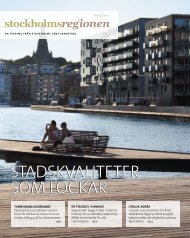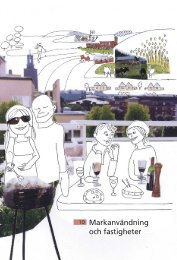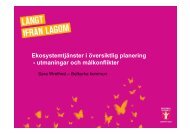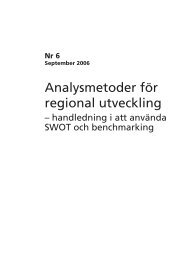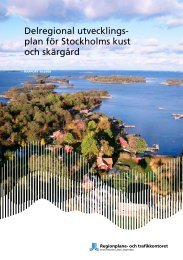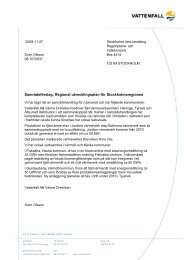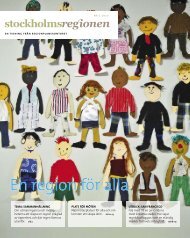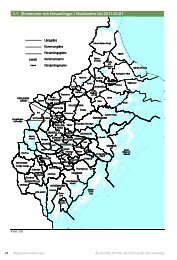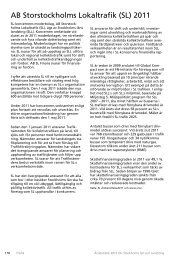- Page 1 and 2:
Stock holm- region i till växtPlan
- Page 4 and 5:
Stockholm- region i tillväxtPlaner
- Page 6 and 7:
InnehållInledning 7DEL 1 - FÖRUTS
- Page 8 and 9:
INLEDNING7InledningEN UNIK PLANERIN
- Page 10 and 11:
INLEDNING9metoder som använts. Reg
- Page 12 and 13:
DEL 1Förutsättningarna
- Page 14:
1.1Regionplaneringeni det svenska p
- Page 17 and 18:
16DEL 1 - FÖRUTSÄTTNINGARErfarenh
- Page 19 and 20:
18DEL 1 - FÖRUTSÄTTNINGARkar idag
- Page 21 and 22:
20DEL 1 - FÖRUTSÄTTNINGARdet änn
- Page 23 and 24:
22DEL 1 - FÖRUTSÄTTNINGARtemet ut
- Page 25 and 26:
24DEL 1 - FÖRUTSÄTTNINGARpolitiko
- Page 27 and 28:
26DEL 1 - FÖRUTSÄTTNINGARRubriker
- Page 29 and 30:
28DEL 1 - FÖRUTSÄTTNINGARprövnin
- Page 31 and 32:
30DEL 1 - FÖRUTSÄTTNINGARFORTSATT
- Page 34:
DEL 2Processen
- Page 37 and 38:
36DEL 2 - PROCESSENDet är vanligt
- Page 39 and 40:
38DEL 2 - PROCESSENEKONOMISK UTVECK
- Page 41 and 42:
40DEL 2 - PROCESSENBEFOLKNINGSÖKNI
- Page 44 and 45:
2.2En regional strategiRegionplane-
- Page 46 and 47:
EN REGIONAL STRATEGI45gärder disku
- Page 48 and 49:
EN REGIONAL STRATEGI47programskrift
- Page 50 and 51:
EN REGIONAL STRATEGI49TIDPLANEN SPR
- Page 52 and 53:
EN REGIONAL STRATEGI516. Skydda reg
- Page 54 and 55:
EN REGIONAL STRATEGI53REMISSVAREN P
- Page 56 and 57:
EN REGIONAL STRATEGI55arbetet. De v
- Page 58 and 59:
EN REGIONAL STRATEGI57en upprepning
- Page 60 and 61:
EN REGIONAL STRATEGI59stimulera nä
- Page 62 and 63:
2.3Regional utvecklingsplan- samrå
- Page 64 and 65:
REGIONAL UTVECKLINGSPLAN - SAMRÅDS
- Page 66 and 67:
REGIONAL UTVECKLINGSPLAN - SAMRÅDS
- Page 68 and 69:
REGIONAL UTVECKLINGSPLAN - SAMRÅDS
- Page 70 and 71:
REGIONAL UTVECKLINGSPLAN - SAMRÅDS
- Page 72 and 73:
REGIONAL UTVECKLINGSPLAN - SAMRÅDS
- Page 74 and 75:
REGIONAL UTVECKLINGSPLAN - SAMRÅDS
- Page 76 and 77:
REGIONAL UTVECKLINGSPLAN - SAMRÅDS
- Page 78 and 79:
REGIONAL UTVECKLINGSPLAN - SAMRÅDS
- Page 80 and 81:
REGIONAL UTVECKLINGSPLAN - SAMRÅDS
- Page 82 and 83:
REGIONAL UTVECKLINGSPLAN - SAMRÅDS
- Page 84 and 85:
REGIONAL UTVECKLINGSPLAN - SAMRÅDS
- Page 86 and 87:
2.4Från samrådsunderlagtill RUFS
- Page 88 and 89:
FRÅN SAMRÅDSUNDERLAG TILL RUFS 20
- Page 90 and 91:
FRÅN SAMRÅDSUNDERLAG TILL RUFS 20
- Page 92 and 93:
FRÅN SAMRÅDSUNDERLAG TILL RUFS 20
- Page 94 and 95:
FRÅN SAMRÅDSUNDERLAG TILL RUFS 20
- Page 96 and 97:
FRÅN SAMRÅDSUNDERLAG TILL RUFS 20
- Page 98:
DEL 3Formerna
- Page 101 and 102:
100DEL 3 - FORMERNAFör trafikplane
- Page 103 and 104:
102DEL 3 - FORMERNAsiktigt uthålli
- Page 105 and 106:
104DEL 3 - FORMERNAbättre socialt
- Page 107 and 108:
106DEL 3 - FORMERNAatt handla om hu
- Page 109 and 110:
108DEL 3 - FORMERNAProfessor Folke
- Page 111 and 112:
Stockholms stad.Den funktionella re
- Page 113 and 114:
112DEL 3 - FORMERNAKarta över Mäl
- Page 115 and 116:
114DEL 3 - FORMERNAbostadsförsörj
- Page 117 and 118:
116DEL 3 - FORMERNA• Planering sy
- Page 119 and 120:
118DEL 3 - FORMERNARegionplan 1991
- Page 121 and 122:
120DEL 3 - FORMERNAÖstersjön. Lan
- Page 123 and 124:
122DEL 3 - FORMERNApolitiskt på de
- Page 125 and 126:
Slussen 1950.Trafikanläggningen vi
- Page 127 and 128:
126DEL 3 - FORMERNAproblem ökar f
- Page 129 and 130:
128DEL 3 - FORMERNAArbetet med att
- Page 131 and 132:
130DEL 3 - FORMERNAEKONOMISKA KONSE
- Page 133 and 134:
132DEL 3 - FORMERNAplaneringsarbete
- Page 135 and 136:
134DEL 3 - FORMERNASödra länken f
- Page 137 and 138:
136DEL 3 - FORMERNALinnakivi från
- Page 139 and 140:
138DEL 3 - FORMERNANaturvårdsverke
- Page 142 and 143:
3.4Metoder och modellerRegionplane-
- Page 144 and 145:
METODER OCH MODELLER143ned sina per
- Page 146 and 147:
METODER OCH MODELLER145T/RIM (Trans
- Page 148 and 149:
METODER OCH MODELLER147prioritet, m
- Page 150:
METODER OCH MODELLER149att förbät
- Page 153 and 154:
Stockholmsregionens befolkning öka
- Page 155 and 156:
154DEL 4 - NÅGRA SAKFRÅGORBefolkn
- Page 157 and 158:
156DEL 4 - NÅGRA SAKFRÅGOReventue
- Page 159 and 160:
158DEL 4 - NÅGRA SAKFRÅGORTrots d
- Page 161 and 162:
På 1950-talet fick mångaflerbarns
- Page 163 and 164:
162DEL 4 - NÅGRA SAKFRÅGORDiagram
- Page 165 and 166:
164DEL 4 - NÅGRA SAKFRÅGORDiagram
- Page 167 and 168:
166DEL 4 - NÅGRA SAKFRÅGORAndel h
- Page 169 and 170:
168DEL 4 - NÅGRA SAKFRÅGORmed i v
- Page 171 and 172:
170DEL 4 - NÅGRA SAKFRÅGORVidare
- Page 173 and 174:
172DEL 4 - NÅGRA SAKFRÅGORhandlat
- Page 175 and 176:
174DEL 4 - NÅGRA SAKFRÅGORmiss, v
- Page 177 and 178:
176DEL 4 - NÅGRA SAKFRÅGORBostads
- Page 179 and 180:
178DEL 4 - NÅGRA SAKFRÅGORangett
- Page 181 and 182:
180DEL 4 - NÅGRA SAKFRÅGORmed hö
- Page 183 and 184:
182DEL 4 - NÅGRA SAKFRÅGORredda a
- Page 185 and 186:
Tätortsstruktureni Mälardalen har
- Page 187 and 188:
186DEL 4 - NÅGRA SAKFRÅGORnella s
- Page 189 and 190:
188DEL 4 - NÅGRA SAKFRÅGOREtt und
- Page 191 and 192:
190DEL 4 - NÅGRA SAKFRÅGORutan li
- Page 193 and 194:
192DEL 4 - NÅGRA SAKFRÅGORSkalfö
- Page 195 and 196:
194DEL 4 - NÅGRA SAKFRÅGORRegiona
- Page 197 and 198:
196DEL 4 - NÅGRA SAKFRÅGOREnkärn
- Page 199 and 200:
198DEL 4 - NÅGRA SAKFRÅGOROvan: I
- Page 202 and 203:
4.4TrafikfrågornaBILEN - FRIHETSSY
- Page 204 and 205:
TRAFIKFRÅGORNA203bilavgifter, men
- Page 206 and 207:
TRAFIKFRÅGORNA205tisk förankring,
- Page 208 and 209:
TRAFIKFRÅGORNA207regionen skulle u
- Page 210 and 211:
TRAFIKFRÅGORNA209antagna planen ha
- Page 212 and 213:
TRAFIKFRÅGORNA211skäl var en ny f
- Page 214 and 215:
TRAFIKFRÅGORNA213värdefullt i sig
- Page 216 and 217:
TRAFIKFRÅGORNA215Resultatet av sty
- Page 218 and 219:
TRAFIKFRÅGORNA2172. reducera flask
- Page 220 and 221:
TRAFIKFRÅGORNA219ägnades betydlig
- Page 222 and 223:
TRAFIKFRÅGORNA221”fel” håll h
- Page 224 and 225:
TRAFIKFRÅGORNA223minister Ulrica M
- Page 226 and 227:
TRAFIKFRÅGORNA225
- Page 228 and 229:
4.5Getingmidjan- Stockholms pulsåd
- Page 230 and 231:
GETINGMIDJAN - STOCKHOLMS PULSÅDER
- Page 232 and 233:
GETINGMIDJAN - STOCKHOLMS PULSÅDER
- Page 234 and 235:
GETINGMIDJAN - STOCKHOLMS PULSÅDER
- Page 236 and 237:
GETINGMIDJAN - STOCKHOLMS PULSÅDER
- Page 238 and 239:
GETINGMIDJAN - STOCKHOLMS PULSÅDER
- Page 240 and 241:
4.6Nord-sydliga vägförbindelserSk
- Page 242 and 243:
NORD-SYDLIGA VÄGFÖRBINDELSER241Es
- Page 244 and 245:
NORD-SYDLIGA VÄGFÖRBINDELSER243in
- Page 246 and 247:
NORD-SYDLIGA VÄGFÖRBINDELSER245Ce
- Page 248 and 249:
NORD-SYDLIGA VÄGFÖRBINDELSER247En
- Page 250 and 251:
NORD-SYDLIGA VÄGFÖRBINDELSER249ut
- Page 252 and 253:
NORD-SYDLIGA VÄGFÖRBINDELSER251V
- Page 254 and 255:
4.7FlygplatserTillräcklig flygplat
- Page 256 and 257:
FLYGPLATSER255Med åren har Bromma
- Page 258 and 259:
FLYGPLATSER2571980-talet. Den milit
- Page 260 and 261:
FLYGPLATSER259Prognos 1965-2000 fö
- Page 262 and 263:
FLYGPLATSER261lägga enbart för al
- Page 264 and 265:
FLYGPLATSER263
- Page 266 and 267: BEFOLKNINGSTILLVÄXTEN265
- Page 268 and 269: FLYGPLATSER267
- Page 270 and 271: FLYGPLATSER269
- Page 272 and 273: FLYGPLATSER271
- Page 274 and 275: FLYGPLATSER273Fysiskt tänkbara fly
- Page 276 and 277: FLYGPLATSER275LOBBYING FRÅN OLIKA
- Page 278 and 279: FLYGPLATSER277Bromma flygplats, med
- Page 280 and 281: FLYGPLATSER279Utvecklingen av antal
- Page 282 and 283: FLYGPLATSER281STATUS QUO FÖR FLYGE
- Page 284 and 285: DEL 5Resultatet
- Page 286 and 287: 5.1Har regionen enats?UTVÄRDERING
- Page 288 and 289: HAR REGIONEN ENATS?287Naturligtvis
- Page 290 and 291: HAR REGIONEN ENATS?289Dagens Nyhete
- Page 292 and 293: HAR REGIONEN ENATS?291STOCKHOLMSBER
- Page 294 and 295: HAR REGIONEN ENATS?293områden på
- Page 296: HAR REGIONEN ENATS?295regelsystem s
- Page 299 and 300: 298DEL 5 - RESULTATETC-F Ahlberg so
- Page 301 and 302: 300DEL 5 - RESULTATETkraft, bygga g
- Page 303 and 304: 302DEL 5 - RESULTATETkansorgan i fo
- Page 305 and 306: 304DEL 5 - RESULTATETbundsfrågan,
- Page 307 and 308: 306DEL 5 - RESULTATETrådet till et
- Page 310 and 311: 5.3Tolv lärdomar för framtidenUti
- Page 312 and 313: TOLV LÄRDOMAR FÖR FRAMTIDEN311Att
- Page 314 and 315: TOLV LÄRDOMAR FÖR FRAMTIDEN313Det
- Page 318 and 319: SUMMARY317Cultivation (Odlingen) we
- Page 320 and 321: SUMMARY319There was strong support
- Page 322 and 323: SUMMARY321for regional planning. A
- Page 324 and 325: SUMMARY323authority Banverket prese
- Page 326: SUMMARY325Lessons for the FutureOn
- Page 329 and 330: 328APPENDIXBokens författare Göra
- Page 331 and 332: 330APPENDIXNoterInledning1. Stockho
- Page 333 and 334: 332APPENDIX5. Social atlas för Sto
- Page 335 and 336: 334APPENDIX2. Se även Flerkärnig
- Page 337 and 338: 336APPENDIX20. Skrivelse från de s
- Page 339 and 340: 338APPENDIX1999:18 Skiss 99 - Under
- Page 341 and 342: 340APPENDIXLänsplan för regional
- Page 343 and 344: 342APPENDIXDiagonal Ulvsunda 250Dju
- Page 345 and 346: 344APPENDIXLilla Essingen 240Lindar
- Page 347 and 348: 346APPENDIXSIF 36, 101Sigtuna 62, 1
- Page 349 and 350: 348APPENDIXVästerleden 39, 74, 207
- Page 351 and 352: 350APPENDIXIIngo, Susanne 48, 50, 6
- Page 353: Stockholm - region i tillväxtPlane







